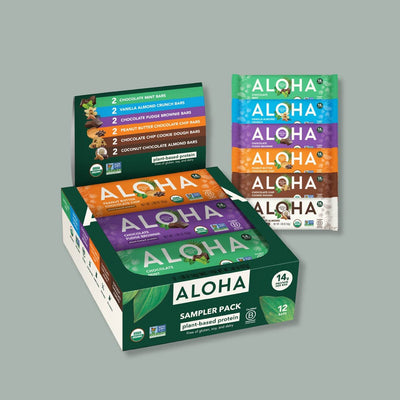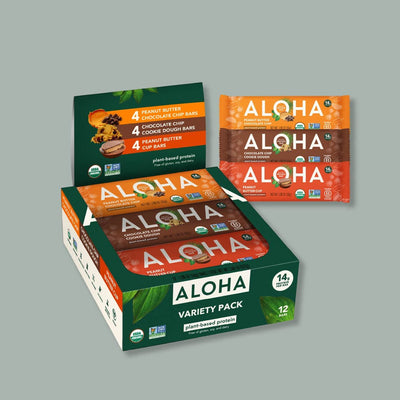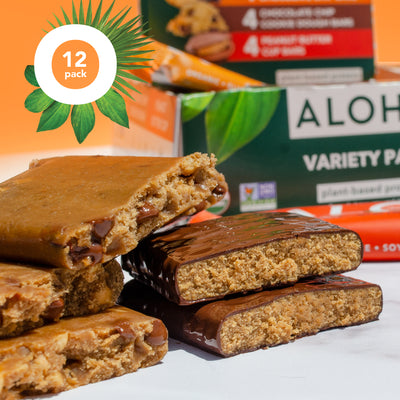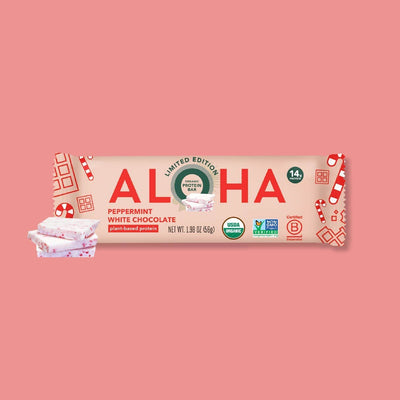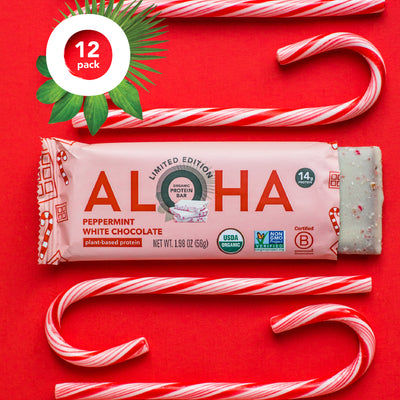Key Takeaways:
- Almond Butter Is Simple: Most almond butters are made with almonds and sometimes some salt. This makes it a clean, easy choice for anyone avoiding overly processed foods.
- Read the Label: Ingredients can vary between brands, so it's important to check for added sugars or oils. Look for options that align with organic and non-GMO preferences.
- Easy to Use Anytime: Almond butter works well with breakfast, snacks, or light meals. Its versatility makes it a useful pantry staple throughout the day.
Is almond butter truly deserving of all its attention in kitchens today? As more people seek clean, simple foods that fit a plant-based and organic lifestyle, almond butter has quickly become a favorite. Its rich texture and natural roots make it an easy addition to meals and snacks without feeling like a compromise.
At ALOHA, eating well should feel good, and taste even better. Every product we create is rooted in organic, sustainably sourced ingredients, with no shortcuts or compromises. We are proud to make it easier for people to find foods they trust, made with transparency, care, and a commitment to quality you can feel with every bite.
In this piece, we’ll explore whether almond butter is as healthy as it seems, highlight what sets it apart, and share how you can choose the best options for your lifestyle.
Nutritional Profile Of Almond Butter
Almond butter is often appreciated for its straightforward, natural ingredient list. Typically made from just roasted almonds — and sometimes a pinch of salt — it offers a simple way to enjoy the full flavor of the nut without unnecessary extras. For those paying attention to what goes into their bodies, the minimal processing of almond butter makes it an easy addition to a clean-eating lifestyle.
While the exact nutritional values can vary between brands, almond butter generally contains a balance of fats, carbohydrates, and a modest amount of plant-based protein. It also provides natural nutrients in almonds, like magnesium and vitamin E. Thanks to its dense, creamy texture, a small amount can add richness and satisfaction to various meals and snacks.
Health Benefits Of Almond Butter
Almond butter offers more than just great taste; it brings a natural richness that fits easily into various diets. While it’s often enjoyed for its creamy texture and satisfying flavor, there are several reasons why people appreciate adding it to their meals. Here’s a closer look at what almond butter can offer:
Naturally Satisfying Texture And Flavor
Almond butter’s thick, creamy consistency provides a sense of satisfaction that many people find comforting. Its rich flavor pairs well with various foods, from fruits to whole-grain breads. This versatility makes it a go-to choice for those looking to add something indulgent yet simple to their daily routines.
Plant-Based Nutrient Variety
Because almond butter is made from almonds, it brings the natural diversity of plant-based nutrients into your diet. Nutrients like magnesium, potassium, and vitamin E are naturally present in almonds and stay intact in the butter form. This variety allows individuals to enjoy more nutrient-dense foods without relying heavily on supplements or processed alternatives.
Fits A Range Of Lifestyles
Whether someone is following a plant-based diet, aiming for organic choices, or simply seeking foods with recognizable ingredients, almond butter easily fits the bill. Its minimal processing and straightforward ingredient list align with many popular eating styles today. This makes it a versatile pantry item that can be enjoyed in countless ways, from breakfast to late-night snacks.
Simple, Recognizable Ingredients
One of the most appreciated aspects of almond butter is the simplicity of its ingredients. With most varieties containing only almonds — and occasionally a pinch of salt — it’s a product that keeps things straightforward. This makes it easier for individuals to choose foods that align with clean-eating habits without second-guessing what’s inside the jar.
Pairs Easily With Other Nutrient-Rich Foods
Almond butter's versatile flavor complements nutrient-dense foods like fruits, oats, and vegetables. Its creamy texture adds depth to meals and snacks without overpowering other ingredients. This flexibility makes it a popular addition to quick snacks and more thoughtfully prepared dishes.
How To Choose The Healthiest Almond Butter
With so many options lining grocery store shelves, picking the right almond butter can feel overwhelming. Some brands keep it simple and pure, while others add unnecessary extras that may not align with a clean, plant-based lifestyle. Here’s what to keep in mind when selecting almond butter:
- Look for Short Ingredient Lists: The best almond butter options typically have just one or two ingredients: almonds and maybe a small amount of salt. A shorter ingredient list means fewer additives, keeping the product as close to its natural form as possible. Reading the label carefully can help you find a jar that fits your commitment to simplicity and quality.
- Avoid Added Sugars and Oils: Some almond butters contain added sugars, palm oil, or other fillers that can detract from the almonds' natural goodness. Choosing a product without these extras helps keep your food choices more straightforward and intentional. It’s always worth taking an extra moment to scan the label for unnecessary ingredients.
- Prioritize Organic and Non-GMO Options: Organic and non-GMO almond butters are strong choices for those who value organic farming practices and transparency in food production. These products are made with almonds grown without synthetic pesticides or genetic modification. Selecting certified organic and non-GMO options aligns with a clean, mindful eating lifestyle.
- Consider the Texture and Roasting Method: Depending on personal preference, almond butters can vary from smooth to crunchy and from raw to roasted. Raw almond butter offers a lighter flavor, while roasted versions bring a deeper, nuttier taste. Knowing your preferred texture and roasting method can make your almond butter experience even more enjoyable.
- Check for Transparent Sourcing Practices: Brands that openly share where their almonds are sourced from demonstrate a commitment to quality and ethical production. Transparent sourcing often reflects higher standards in how ingredients are grown and processed. Choosing brands that prioritize this level of openness can add an extra layer of trust to your purchase.
How To Incorporate Almond Butter Into Your Diet
Almond butter’s rich flavor and versatile texture make it an easy addition to simple snacks and elaborate meals. Whether you’re looking for a quick boost during a busy day or a new way to add depth to your favorite recipes, almond butter fits right in. Here are some easy ideas to get you started:
Spread It On Toast Or Rice Cakes
One of the simplest ways to enjoy almond butter is by spreading it over whole-grain toast or rice cakes. It adds a creamy texture and a naturally rich flavor without complicated preparation. Topping it with a few slices of banana or a sprinkle of seeds can create a satisfying and balanced snack.
Blend It Into Smoothies
Adding a spoonful of almond butter to a smoothie can create a richer, creamier texture and a subtle nutty flavor. It pairs especially well with fruits like bananas, berries, and even leafy greens. This small addition can turn an ordinary smoothie into a more filling and flavorful treat.
Stir It Into Oatmeal Or Yogurt
Almond butter blends smoothly into warm oatmeal or creamy yogurt, adding a gentle nutty note that enhances sweet and savory flavors. A tablespoon can make a bowl of oats or yogurt feel more indulgent and satisfying. Mixing it in while the oatmeal is hot helps the almond butter melt in beautifully.
Use It In Baking
Almond butter is a delicious ingredient in homemade baked goods like cookies, muffins, and bars. It offers a naturally rich taste and a moist texture that complements a wide range of recipes. Many use it as a partial substitute for traditional fats or spreads in baking projects.
Drizzle It Over Fruits Or Vegetables
Almond butter can be drizzled over apple slices, celery sticks, or roasted vegetables for a quick and wholesome snack. Its creamy texture adds something extra without overwhelming the natural flavors of the produce. This simple addition makes everyday fruits and veggies feel more special.
Best Times To Eat Almond Butter For Maximum Benefits
Almond butter’s versatility makes it easy to enjoy at different points throughout the day. Whether you're fueling up in the morning or reaching for a simple snack later on, there are many ways to work it into your routine. Here’s when almond butter often fits naturally into your day:
- In the Morning with Breakfast: Starting the day with a small amount of almond butter can add richness and flavor to common breakfast staples. Whether spread on toast, stirred into oatmeal, or blended into a smoothie, it’s a simple way to create a more satisfying meal. Many people find that a balanced breakfast feels more complete with added almond butter.
- As a Mid-Morning Snack: When the morning starts to stretch and hunger kicks in, almond butter can offer a quick and easy option. A spoonful paired with apple slices or a handful of berries can create a simple snack without much effort. Its creamy texture and nutty flavor make it a popular mid-morning go-to.
- In the Afternoon to Bridge Meals: Busy afternoons often call for something easy to grab that doesn’t require much preparation. Almond butter spread on a rice cake or dipped with carrot sticks can provide a moment of calm in a hectic schedule. Choosing almond butter for an afternoon snack keeps things straightforward and satisfying.
- As Part of an Evening Treat: Almond butter can be a cozy addition to evening snacks or light desserts. Drizzling it over a baked sweet potato, blending it into a warm smoothie, or adding it to a homemade energy bite can make evening meals feel more special. It’s simple to end the day with something familiar and comforting.
- Before or After an Active Session: For those who like a little fuel around exercise, almond butter can fit into small snacks either before or after activities. Spreading a thin layer on whole-grain crackers or adding it to a smoothie can create an easy option without much prep. It’s a flexible food that suits many different movement routines.
Final Thoughts
Almond butter is more than a trendy spread — it reflects a growing desire for simpler, more mindful eating. Its appeal lies not just in its rich flavor and satisfying texture, but in its values: transparency, quality, and respect for natural ingredients. Choosing almond butter isn’t just a nutritional decision; it’s a small, everyday choice that supports a lifestyle rooted in balance, authenticity, and care for what we put into our bodies. As with any food, being mindful of what’s inside the jar matters — and when you find the right one, almond butter becomes more than a staple; it becomes a trusted companion on the journey to eating well.
Read also:
- Healthy Work Snacks For Busy Days
- Best Healthy Snacks For Traveling On The Go
- Snack Ideas For School: Healthy, Quick, And Easy Options
Frequently Asked Questions About Is Almond Butter Healthy
Can almond butter be part of a plant-based diet?
Yes, almond butter fits naturally into a plant-based diet because it is made entirely from almonds. It’s a simple way to add variety without relying on animal-based ingredients. Always check for simple labels to keep your choices clean and aligned.
Is almond butter better than other nut butters for everyday use?
Almond butter has a mild, slightly sweet flavor, making it versatile compared to other nut butters. While "better" depends on taste preferences, many people enjoy almond butter for its smooth texture. It pairs well with both sweet and savory foods.
Does almond butter contain added preservatives?
Most pure almond butters do not contain preservatives, but it’s always best to read the label. Some brands may add stabilizers to extend shelf life. Choosing almond butters with only almonds (and maybe salt) keeps things simple and closer to natural.
How long does almond butter stay fresh after opening?
Once opened, almond butter generally stays fresh for about 3 to 6 months if stored properly. Keeping it in a cool, dark place, or even refrigerating it, helps maintain its quality. Always stir it well if natural oils separate over time.
Can almond butter be included in savory dishes?
Yes, almond butter can add depth to savory dishes like sauces, dressings, and marinades. Its mild, nutty flavor blends well with herbs, spices, and soy sauce or vinegar. It's a creative way to add richness without overpowering the dish.
Does almond butter contain fiber naturally?
Almond butter contains fiber naturally since it’s made from whole almonds. Fiber content may vary slightly based on the brand and processing methods. Choosing almond butter that keeps the skin of the almond intact usually means slightly more fiber.
Why does oil separate in natural almond butter?
Oil separation happens because natural almond butter doesn’t use stabilizers to emulsify the mixture. It’s a sign of minimal processing, not spoilage. Simply stirring the almond butter before using helps bring it back to a creamy consistency.
Is almond butter considered shelf-stable?
Yes, most almond butters are shelf-stable and do not require refrigeration until opened. After opening, storage preferences depend on climate and usage habits. Always check for brand-specific guidance on the packaging.
Can almond butter be used in gluten-free diets?
Absolutely — almond butter is naturally gluten-free. It's made from almonds, which do not contain gluten. Just be sure the product isn't processed in a facility that handles gluten-containing items if cross-contamination is a concern.
Can almond butter be part of a minimalist pantry?
Yes, almond butter is a great fit for minimalist or simplified pantries due to its versatility and simple ingredient list. It can be used in many ways without extra products or complicated recipes. Choosing a jar with just almonds and salt aligns things with a less-is-more approach.
Sources:
1. Chen, C.-Y., Lapsley, K., & Blumberg, J. (2006). A nutrition and health perspective on almonds. Journal of the Science of Food and Agriculture, 86(14), 2245–2250. https://doi.org/10.1002/jsfa.2659
2. Barreca, D., Nabavi, S. M., Sureda, A., Rasekhian, M., Raciti, R., Silva, A. S., Annunziata, G., Arnone, A., Tenore, G. C., Süntar, İ., & Mandalari, G. (2020). Almonds (Prunus Dulcis Mill. D. A. Webb): A Source of Nutrients and Health-Promoting Compounds. Nutrients, 12(3), 672. https://doi.org/10.3390/nu12030672
3. Gorrepati, K., Balasubramanian, S., & Chandra, P. (2014). Plant based butters. Journal of Food Science and Technology, 52(7), 3965–3976. https://doi.org/10.1007/s13197-014-1572-7
ALOHA's products are not intended to treat, diagnose, mitigate, prevent, or cure disease. ALOHA's products should not replace prescribed medications or the variety of foods important to a healthful diet.
Do not self-diagnose any health condition. Work with your healthcare provider to determine how best to achieve optimal health.





